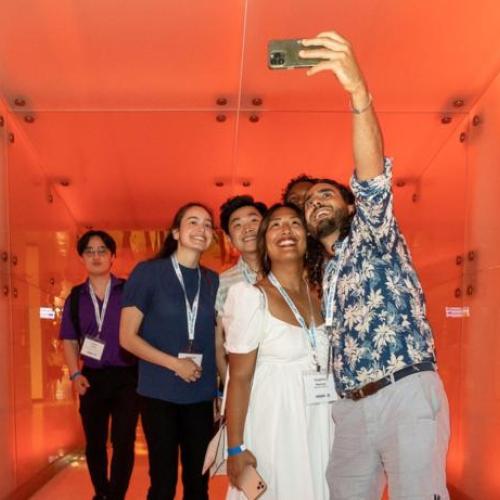April 11, 2025 | Alumni
“This residency changed the trajectory of my career,” says U of T alumna featured in solo photography show
By Megan Wykes
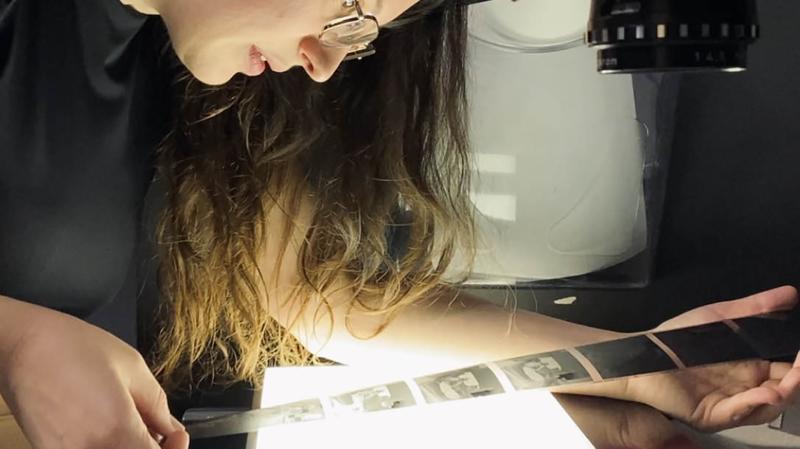
The unforgettable work of Darkroom Artist in Residence Teresa Hulinska is featured in the Hart House Camera Club’s Talking Walls exhibition space
It hasn't been long since Teresa Hulinska (BSc 2016) was a University of Toronto undergrad majoring in psychology with no plans for a future in photography. “I had no idea. I was figuring out what path my life was going to take, trying to balance the practicalities of employment and finding something I wanted to do with my life.”
Then the pandemic hit. She had time on her hands and, concurrently, began to disconnect at her corporate IT job. “I needed some kind of art in my life,” she explains.
So, she started taking pictures. “I think photography stuck because you can take it with you everywhere. The barrier to entry is very low: You can start with your phone. That's what I did.”
Teresa’s aesthetic eye developed rapidly, as she began considering scenes for their composition and storytelling potential.
She also discovered a creative community, joining groups like Queer Photography Club, which she now helps to organize. “That’s what I lacked in my professional life. It was amazing to be shooting in a space where I could be myself.”
Opening question: “Is there a story in front of me?”
When Teresa started street photography, she worked quickly, without being fully immersed in the scene. But over time she slowed down and began to ask herself, “Is there a story in front of me? Is there something happening? Is there an interesting character? I love seeing people living and doing their thing.”
Motion and light are also important. “If there's an interesting quality of light that isn't something you typically see, I love to capture that.”
When she graduated from using her phone’s camera to a ‘real’ camera, and began shooting in a larger format, the production costs grew, making her even more selective deciding what she wanted to capture. “This helped me craft in the moment … Part of why I chose film as a medium is that I needed to slow down, be intentional.”
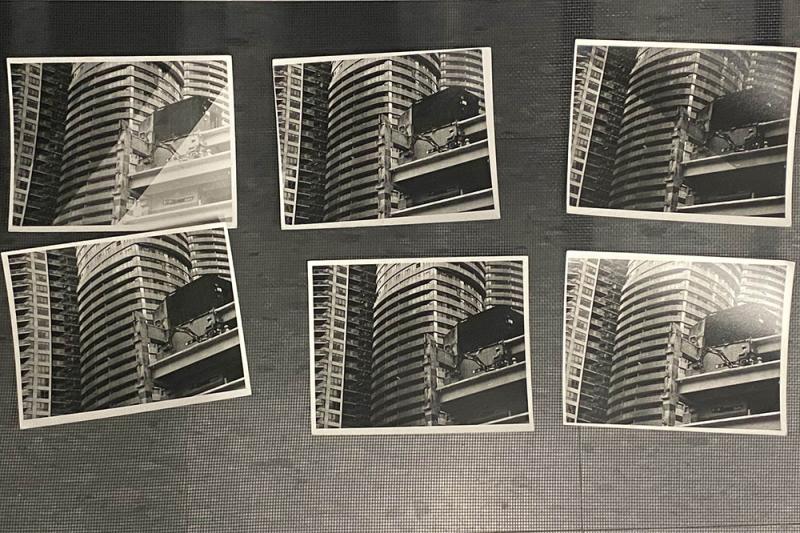
Connecting with Hart House changed her life
Funnily enough, Teresa connected with the Hart House Camera Club by applying to a job for which she was ineligible – the position was intended for students. Saša Rajšić, coordinator, Integrated Arts Education, nevertheless, took note of her work. Impressed, he reached out.
She soon gained access to the darkroom and began developing film, which she describes as transformational. “Students were coming in, using the space … They were so generous with their time, teaching me how to do things.”
She applied to the Hart House Camera Club’s 2024-2025 Dark Room Artist in Residence program. Running from fall to spring, this initiative offers students or emerging photographers a chance to develop a new body of work that explores themes around Toronto. The Residency also includes a darkroom workshop, facilitated by the artist, and a concluding solo exhibition.
Being accepted into the program caught her off guard, especially since she had seen the breathtaking work of other Artists in Residence, such as Masoud Riyazati and Dainesha Nugent-Palache.
Teresa has been working in this capacity since September 2024. The impact has been immeasurable. She says that while her time at U of T taught her how to think, Hart House launched her professional aspirations. “This Residency completely changed the trajectory of my career, 100%.”
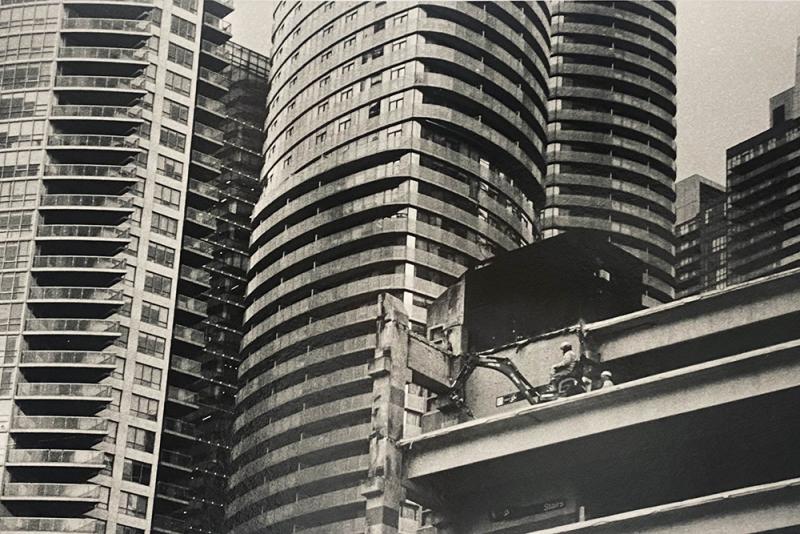
Themes of timelessness
There are hallmarks, such as timelessness, in her black and white photos. Viewers sense that the images could very well have been captured in any era, and yet, there will be a small clue, like a cellphone, that hints at present time. “The photographs are grounded in the present, but the moods, emotions and humanity are timeless,” she explains.
Section 37, her show that opened March 26 and runs through April 17, speaks to this duality of being rooted in time and also timeless. “The issues that I'm raising are specifically set in Toronto today, but they stretch around the world and have always been issues.”
The uneasy tension behind Section 37
The development of the Section 37 show stemmed from Teresa’s discussions with Toronto City Staff who “painted a picture of a world I had no idea existed.” Section 37 of the Toronto Planning Act authorizes the City to make zoning changes in exchange for essential services during the approval process of new developments.
“It’s a way for wards to get some kind of public space or community benefit. It involves negotiating with developers who, obviously, want to maximize profits,” Teresa explains.
Finding a middle ground between the developers’ profit margins, a healthy population density and community benefits, like green space and artwork, is key. This is the tricky work of Councillors, lobbyists and community organizers. Getting all the public spaces ‘right’ is a challenge.
Decision making, with this muddle of stakeholders, is not always a transparent process. “We know what happens when decisions that should involve everyone are made behind closed doors. It’s important to think about all the pressures,” Teresa emphasizes.
Her new work reflects these pressures. There’s a compelling narrative about the interplay between privatization, technology and greed; and people in power, making decisions on what is built for our communities – more specifically, those people with a disproportionate say in that process. “Then the rest of us have to live in that space and find a way to survive or thrive. That’s not always easy when our input isn't valued as much as that from someone with money and power,” she says.
This is the meaty cerebral terrain of Teresa’s new photography wherein hostile architecture overshadows individuals – workers, barely visible on an urban construction site, surrounded by mammoth buildings; three lonely silhouettes waiting for their food truck orders; or a two people scurrying along a nocturnal sidewalk bombarded by enormous billboards. There is a haunting sadness or hopelessness to these small figures, eclipsed by the expansive cityscape with its “top-down energy.”
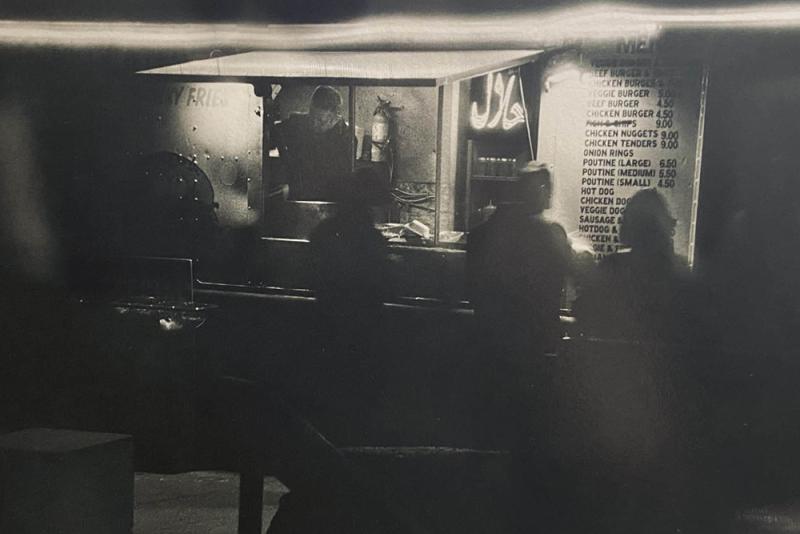
Support of Hart House meant everything
Teresa is grateful to Saša for believing in her work. “I was seeking community, support and a place to grow … and Saša gifted that to me. Hart House creates such a vibrant space where things are constantly happening. Yes, it’s student centric, but there’s also a space for community members. That spirit of sharing is so special.”
This experience was a game-changer for Teresa. She still plans to pursue commercial photography to sustain herself professionally. “But now, this opportunity opened up a completely new trajectory for me.”
She won’t be a stranger. “This relationship with Hart House is so much bigger than I expected. It’s something I'm going to be engaging with for years to come.”
She has advice for budding student photographers: “Just try a small start, where you feel comfortable, and use whatever tools you have. Keep pushing yourself, learning as much as possible. Take pictures, train your eyes, pursue what moves you.
“You can transform your life. I did not, at first, see a path forward in the arts. But this ache was like a dying love in my heart … so don’t give up.”
